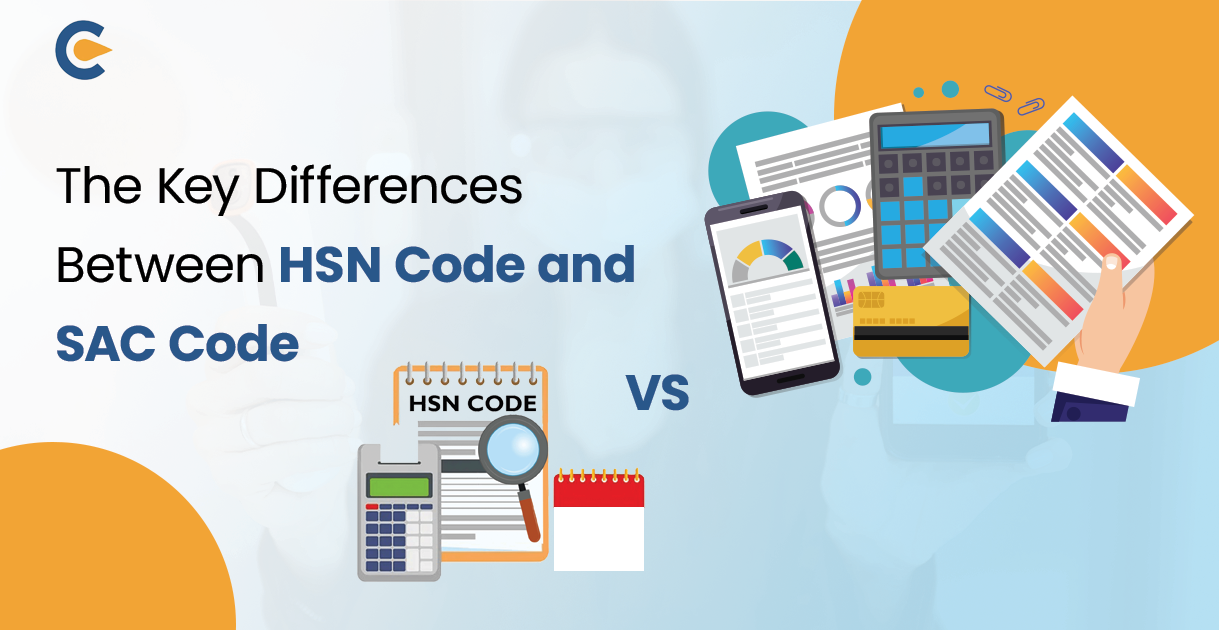There are two important codes followed in India for taxation and international trade: the HSN Code and the SAC Code (Harmonized System of Nomenclature and Service Accounting Code). Though they both pertain to the GST regime, the HSN code is used for taxation purposes, while the SAC code is used for the classification of services.
One of these systems is the HSN Code or Harmonized System of Nomenclature Code, which is strictly developed for the classification of goods or products. The HSN Code takes the form of a universal language for the identification and categorization of merchandise such as clothing, household appliances, food products, and industrial tools. This standardized arrangement helps regulate and reduce ambiguity during the transaction of goods both within the Indian market and the global market. On the other hand, a Service Accounting Code or SAC code is specially designed for services.
I look at it in the same way as an HSN Code is used for physical objects; a SAC Code is applied for services such as consulting, repairs, and entertainment. The SAC Code ensures that taxation and trade related to service-based transactions are not complicated. There is, however, one fundamental difference between the HSN Code and the SAC Code: the former is used for classification, whereas the latter is used for identification.
Streamlining the GST System in India
It is worth mentioning that both HSN and SAC codes are obligatory for invoices and accounting documents, but the HSN is only for goods and the SAC is only for services. Therefore, it is easy to see how the use of the HSN Code and SAC Code helps streamline the GST system in India. It is thus easy for businesses to communicate the nature of the products or services by using the right code, which allows for proper taxation and promotes trade ease even in the global market.
Briefly put, the HSN Code provides a framework for the identification of goods, while the SAC Code does the same for services. The combination of the HSN Code and the SAC Code is the perfect solution to all the issues involved while conducting international trade and paying taxes in India.
Understanding HSN code
The HSN code is one of the internationally recognized conventions of the names and numbers used in classifying traded products. It was initiated by the Customs Cooperation Council, otherwise known as the World Customs Organization (WCO), to simplify world trade and standardize the tariff nomenclature globally. HSN code is structured in a conditioned system; each digit of the code refers to certain divisions. The first digit of the triplet relates to the chapter; the next two digits pertain to the heading, while the final two digits define the sub-heading. This structure provides the basis for breaking down the range of products to fine levels of differentiation depending on the characteristics of the products.
The HSN code system is widely used in a large number of countries. For 200 countries and territories worldwide, the system is used as the base of customs tariffs and compilation of international trade statistics. The customs utilization of this particular system is common since it helps in making objective and comprehensible practices in customs duties, taxes, and commerce policies.
In India, it is used not only in import and export but also as the basis for Goods and Services Tax (GST) during the supply of goods from one state to another. The use of the HSN code system by India ensures compliance with global trends, enhances the organization of trade processes, and increases the efficiency of revenue collection. HSN code, as we know, is a tool that helps in the identification and group classification of products for easy communication between the trader and the customs of any country. The unique and international system also plays a pivotal role in the elimination of barriers to international business opportunities and harmonized trade.
HSN Codes in GST System
The HSN code, also known as the Harmonized System of Nomenclature, is a comprehensive and detailed stepping stone for goods in the GST structure. Initially, it was developed in a six-digit format, but due to the dynamism approved by the Customs and Central Excise authorities, it is now an eight-digit code.
The structure of the HSN code is as follows: the initial two digits pertain to the GST chapter number, the following digits refer to the chapter, the subsequent digits represent subheading, and the last two digits are additional subclassification.
This comprehensive System consists of 21 sections, 99 chapters, 1244 headings, and 5224 subheadings.
Understanding SAC Code
SAC, or Service Accounting Code, is another important classification aid specifically set out by India’s service tax department to classify services. These SAC codes have been developed and incorporated by the GST Council for the execution of the ‘Goods and Services Tax (GST) in the nation. Classification of services through SAC codes helps in the proper application of GST by guiding its correct application.
SAC Code in GST System
The SAC code in GST is a 6-digit number that has been described and prescribed under the GST Law. For instance, the measure of SAC for the IT design and development services is equated to 998314. The first two digits of all SACs are ‘99’, indicating a usual classification of services, the two digits in the Middle (‘83’) identify the major category as IT services. The service design type and development are specified in the last two digits.
Leveraging HSN Code and SAC Code for Effective GST Compliance
In the world of the Goods and Services Tax (GST) regime, accurate classification of goods and services is of primary importance for all businesses to maintain their compliance. This is where the Harmonized System of Nomenclature (HSN) codes for goods and Service Accounting Codes (SAC) for services come into effect. Proper utilization of HSN code and SAC code is essential across various aspects of GST compliance:
1- GST Registration
During the GST registration process, businesses must ensure transparency in the specific goods and services they deal with by providing the relevant HSN and SAC codes. This accurate classification using the HSN code and SAC code will ensure proper compliance from the outset.
2- GST Rate Determination
The GST rates applicable to goods and services are directly connected to their respective HSN code and SAC codes. By correctly identifying these HSN codes and SAC codes, taxpayers will be able to determine the appropriate GST rates effectively, facilitating accurate tax calculations and payments.
3- Invoicing Compliance
When issuing invoices, businesses are required to mention the corresponding HSN codes for goods and SAC codes for services. This requirement of mentioning HSN code and SAC code may change based on the taxpayer’s total turnover, but accurate code disclosure is crucial for maintaining invoicing compliance.
4- GST Returns Filing
During the filing of GST returns, taxpayers must report an HSN Summary, which details the goods and services sold, classified according to their respective HSN and SAC codes. This is required to ensure accurate reporting and reconciliation of tax liabilities.
5- Enabling Seamless GST Implementation
The proper utilization of the HSN and SAC plays a pivotal role in the smooth implementation and compliance with the GST system. These codes will help in the correct classification of goods and services, enabling accurate tax rate determination, invoicing, and reporting. By adhering to the requirements of mentioning the HSN code and SAC code, taxpayers contribute to the transparency and efficiency of the GST framework, fostering a streamlined tax administration process.
The Final Words
Achieving seamless compliance is contingent upon accurately categorizing goods and services. Leveraging the HSN code and SAC code has immense importance across various aspects of GST compliance. During the registration process, businesses must furnish the relevant HSN code and SAC code, ensuring transparency and adherence from the outset. Additionally, the determination of applicable GST rates is intricately tied to the respective HSN code and SAC code, empowering taxpayers to compute and remit taxes with precision.
Furthermore, in the filing of GST returns, taxpayers must submit an HSN Summary, detailing the goods and services sold, classified according to their respective HSN code and SAC code. This critical information facilitates accurate reporting and reconciliation of tax liabilities, fostering transparency and accountability within the system.
By embracing the proper utilization of HSN code and SAC code, businesses actively contribute to the smooth implementation and compliance with the GST system. These codes facilitate the correct classification of goods and services, enabling precise tax rate determination, invoicing, and reporting. Adherence to the requirements of mentioning HSN code and SAC code underscores a commitment to transparency and efficiency within the GST framework, paving the way for a streamlined tax administration process.
As India continues to refine its GST infrastructure, the pivotal roles of the HSN code and SAC code will remain paramount.
Frequently Asked Questions
Are HSN codes and SAC codes unique to India, or are they used globally?
While HSN codes are internationally recognized and used for goods classification, SAC codes are specific to India and have been developed for the GST system to classify services.
What is a SAC code, and how is it different from an HSN code?
The SAC (Service Accounting Code) is a numerical code specifically designed for classifying services in India. While HSN codes are used for goods, SAC codes are used for services, allowing for proper identification and taxation of services under the GST regime.
Why are the HSN and SAC codes important in the GST Systems?
HSN code and SAC code play a crucial role in various aspects of GST compliance, such as registration, rate determination, invoicing, and filing returns. Accurate mention of these codes ensures proper classification, calculation of tax rates, and transparent reporting.
How do HSN and SAC codes help determine GST Rates?
The GST rates applicable to goods and services are directly linked to their respective HSN code and SAC codes. By correctly identifying these codes, taxpayers can accurately determine the appropriate GST rates for their products or services.
Is it mandatory to mention the HSN code and SAC code on invoices?
Yes, businesses are required to mention the corresponding HSN codes for goods and SAC codes for services on invoices issued under the GST system. The specific requirements may vary based on the taxpayer's total turnover.
Read also about GST On Advertising Services – ITC, Rates, HSN Code, Implications & Benefits











